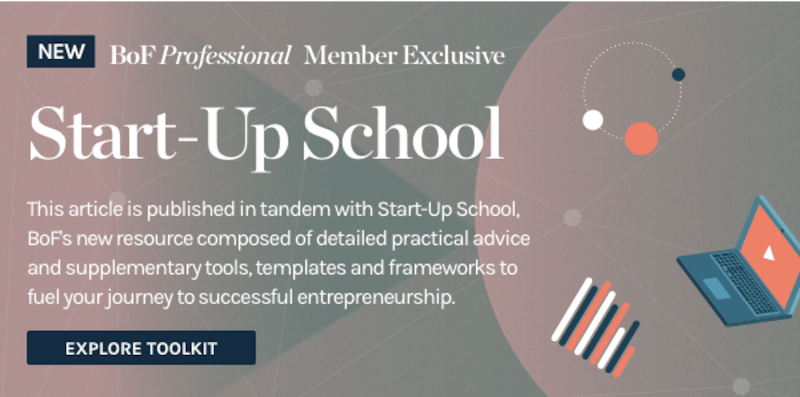
The Business of Fashion
Agenda-setting intelligence, analysis and advice for the global fashion community.

Agenda-setting intelligence, analysis and advice for the global fashion community.

This article is published in tandem with Start-Up School, BoF’s new resource comprised of a practical guide and supplementary tools, templates and frameworks to fuel your journey to successful entrepreneurship. Become a member to access.
Stephen Hawthornthwaite and Roth Martin had two main business priorities when they started Rothy’s in 2012: they wanted their sustainable shoes to be more than a “branding and marketing exercise,” and they wanted to be careful about how they approached raising money.
“I had heard a lot of war stories about raising the Series A, a lot of the game playing that goes on,” said Hawthornthwaite. “That’s just not who we are.”
The founders split the cost of starting the business for years as Rothy’s developed its unusual knit shoe design. Six months after their shoes hit the market in 2015, the company was about to turn a profit and the founders were ready to raise their first round.
ADVERTISEMENT
“What we were able to sell to investors was — here were two people who are relatively mature entrepreneurs, (we were both in our 40s), and both had been successful in prior ventures,” said Hawthornthwaite, adding that their business experience helped offset the fact that they were new to footwear. Finn Capital Partners, Grace Beauty Capital, M13 and Bonobos founder Brian Spaly and others together contributed $2 million in a convertible note.
“I thought we were done at that point, perhaps naively,” says Hawthornthwaite.
Investors who make bets on early-stage businesses are often looking more closely at founders than their business plans, especially in the Seed and Series A rounds.
Early-stage entrepreneurs need to have clear visions and strong convictions, and it always helps to have prior experience starting and scaling a business or special knowledge of their market in order to convince investors to back them.
I had heard a lot of war stories about raising the Series A, a lot of the game playing that goes on.
But they also need to think critically about their investors, who bring something much more valuable than funding: they can fill a knowledge gap.
When Lightspeed Ventures, a venture capital firm, approached Rothy’s in 2016, the founders were eager for partner Jeremy Liew’s knowledge of consumer behaviour, social media tactics and consumer acquisition. The firm was intrigued by the word-of-mouth effect the shoes had. But the Rothy’s founders made clear that they did not want to grow the business too fast — which is often what VC firms push for, in order to exit quickly and profitably, even if it does not bode well for the long-term health of the business. The brand picked up $7 million from Lightspeed in its Series A in 2017.
“I’ve seen too many companies blow up because they grew too fast and couldn’t execute on the growth,” said Hawthornthwaite. The founders were upfront and direct and shared “reasonable” forecasts for the business to ensure they and their prospective investors were on the same page, he said.
The Rothy’s fundraising journey so far, which went on to include a $35 million investment from Goldman Sachs in 2018 which bought out prior stakeholders, isn’t all that unusual. Businesses need money to grow, typically more than can be generated by revenues alone.
ADVERTISEMENT
For an entrepreneur, the fundraising process prompts fundamental questions about the kind of business he or she is trying to build — how big and how fast? Perhaps most importantly, founders need to think carefully about what happens when things don’t go to plan. How will investors react when the business doesn’t fulfil their expectations? Will they trust you when you need to take big leaps? Will they back you through all the ups and downs?
Read on as we break down the key tenets of entrepreneurial early stage fundraising.
Prepare a Business Plan and Projections
Before founders begin the fundraising process, they need to sketch out a strategy. For Erica Cerulo and Claire Mazur, co-founders of e-commerce site Of a Kind, it was as simple as filling out an online business plan template like a homework assignment and using the exercise to get on the same page about their priorities.
I've seen too many companies blow up because they grew too fast and couldn't execute on the growth.
August Bard Bringéus, co-founder of Swedish menswear brand Asket, approached the business plan by outlining the company’s offering, story and customer base. “You realise some initial flaws, and you might uncover some strengths you hadn’t thought about,” he said.
Nick Brown, partner at Imaginary Ventures, advised founders to have ambitious visions but not promise revenue targets too far out in the future. "Sometimes I see founders looking at $100 million in their third year, and they've set a bar that is impossible," he said. "I always say — project down to what you can actually see in front of you, and then tell a vision about how you see the brand evolving."
Network
Finding the right investor is arguably the most critical part of the fundraising process — you need backers who trust your leadership and understand your vision. Work to expand your connections, search platforms like LinkedIn and AngelList, and research industry leaders.
ADVERTISEMENT
Entrepreneurs often receive enquiries when their start-ups are covered by media, though it’s important to carefully determine who is a genuine potential partner, and who is more interested in sniffing out the market. Start networking at least six months before you actually need the money — raising is a lengthy process you don’t want to rush.
Brown said Imaginary Ventures has never made an investment based off of a founder’s cold email pitch, though he reads and tracks those types of messages. “Most of us are pretty accessible, we’re pretty connected, we know entrepreneurs, we know people in the ecosystem, and we’re looking to invest in people who also have built a network,” he said. “It’s the founder’s responsibility to figure out that ecosystem. I always find entrepreneurs are the greatest conduits to other entrepreneurs.”
Nail Down the Terms
You’ve found an investor who respects the business you are trying to build and wants to back you. Now it’s time to agree to a series of terms with long-term consequences if your business succeeds or fails. Valuation is one of the most challenging points to calculate.
I always find entrepreneurs are the greatest conduits to other entrepreneurs.
There are different approaches, but all factor in projections that could be wrong. The lower the valuation, the higher your investor’s share of the ownership and the less equity you have to sell in future rounds of funding. An overly high valuation might raise expectations and make it harder to sell the business later, as the investor will be looking for a return based on the agreed valuation. Brown advised entrepreneurs to be thoughtful about a valuation and not to see it as selling your business for cash. “It’s not realisable in liquid in a real way,” he said. “The impact of raising money at too high of a price can be enormous.”
Valuation is just one of the terms that entrepreneurs need to carefully consider: When and how can investors block or force a sale? How much influence does an investor have on the board? How much control will they have over who you hire to key positions? Who gets their money back first if the company is liquidated through bankruptcy? Check your term sheets carefully and pay for good legal advice. It will stand you in good stead down the road.
Bring In More Backers
You sort out the nuts and bolts of the agreement with the lead investor of a funding round, but usually more investors decide to sign on to back you on the same terms. These investors are called followers. This is beneficial because it brings more potential advisors to your network, and brings in more funding. Rothy’s co-founder Hawthornthwaite said a diverse group of investors is key. “We didn’t want money just for the sake of taking it... What we really wanted were people who could add value.”
Close the Deal
The term sheet is not legally binding, but outlines the terms you have to approve with your investors before agreeing to ink a deal in your shareholder’s agreement. Your lawyers can guide you through the rest of the process: the stock purchase agreement, investors’ rights agreement, government-mandated forms, shareholder and board consent forms, and more.
“The devil is in the details on that for sure,” said Stadium Goods’ co-founder Jed Stiller. The sneaker resale marketplace sold to Farfetch in January 2019, after raising a $4.6 million Series A round from Forerunner Ventures and the Chernin Group in 2017 followed by an $11.5 million convertible note led by LVMH Luxury Ventures the following year.
“We invested a good amount of time and dollars in the direction of our legal support and it was worth its weight in gold,” added co-founder John McPheters.
Editor's Note: This article was revised on April 10, 2019. An earlier version of this article stated that Rothy's secured an investment from Goldman Sachs in 2015. The investment came in 2018.
Related Articles:
[ Chapter 1: Define Your Business ModelOpens in new window ]
[ Chapter 3: Find Product-Market FitOpens in new window ]
[ Chapter 4: Identify Your Target CustomerOpens in new window ]
[ Chapter 5: Build Your Culture as You GrowOpens in new window ]
[ Chapter 6: Scale Your Business CarefullyOpens in new window ]
[ Chapter 7: Plan Your Exit StrategyOpens in new window ]

Designer Carly Mark sparked conversation about what it takes to make it as an emerging designer in New York when she announced she was shutting her ready-to-wear line and moving to London. On Thursday she held her last sample sale.
To stabilise their businesses brands are honing in on what their particular consumer wants to buy, introducing new categories and starting conversations.
That’s the promise of Zellerfeld, a 3D-printing partner to Louis Vuitton and Moncler that’s becoming a platform for emerging designers to easily make and sell footwear of their own.
With a new heavyweight backer in Italian firm Style Capital — which helped Zimmermann secure a billion dollar valuation — the French contemporary womenswear brand has ambitions to go global. But it sits in a competitive and hard-to-crack category.